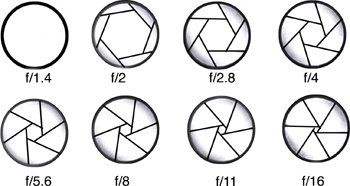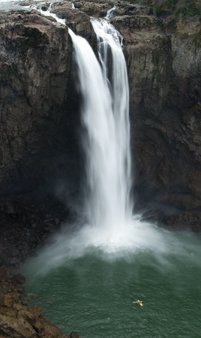Using Aperture Settings
| Aperture Priority, sometimes referred to as AV or Aperture Value, is used when you need to control which parts of your image are in focus. Landscape and portrait photography are almost exclusively shot with Aperture Priority and for exactly the same reason, even though the desired results are polar opposites. Aperture and f-stop BasicsAperture controls depth of field in your images by changing the size of the diaphragm in the lens to control light. Smaller numbers, like 4.0, 3.5, and 2.8, mean a larger opening (Figure 2.8) which allows more light to hit the sensor in less time. This also gives you less depth of field, or range of focus. Figure 2.8. The diaphragm in a lens controls the amount of light passing through to the sensor. Larger openings give shorter exposures and less depth of field.
Each change in aperture, or f-stop, doubles or halves the exposure time, depending on whether the number goes up or down. As you go up in aperture and close the diaphragm, you reduce the amount of light hitting the sensor, and the shutter compensates by leaving the shutter open longer so that roughly the same amount of light ends up hitting the sensor. As an example, if a setting of f/4 gives you an exposure of 1/60 second, changing to f/5.6, the next higher f-stop, doubles the exposure time to 1/30 second. Going the other direction, lowering the f-stop to f/2.8 cuts the exposure time in half, to 1/125 second. Controlling Depth of FieldLet's take a look at some real examples of how aperture settings affect depth of field. In the example shown in Figure 2.9, the lens is set to f/2.8, which gives a narrow depth of field but fast shutter speed. Figure 2.9. This image was captured at f/2.8 with a very shallow depth of field.
Moving the aperture setting to f/8, or three stops, puts more of the image in focus (Figure 2.10). A setting in this range is a good compromise between depth of field and shutter speed, especially when there is movement in the image. Figure 2.10. By adjusting the aperture to f/8, more of the image is in focus.
Finally, by using an aperture setting of f/22, an additional three stops, we've maximized the depth of field to get as much of the image in focus as possible (Figure 2.11), but must now accept a very slow shutter speed to accommodate such a small aperture. This is also ideal for a landscape image where you have detail in the foreground and in the distance that are both important to the image. Figure 2.11. An aperture of f/22 maximizes the area that is in sharp focus.
Another time you use aperture settings creatively is to control exposure time for things such as moving water, where you want that silky smooth look (Figure 2.12). Although you can accomplish the same thing with a Shutter Priority mode setting, it's often quicker to adjust the aperture in the current mode. Doing so changes the shutter speed automatically until it reaches your desired setting, all without taking your eye from the viewfinder. Figure 2.12. You can also use aperture to slow down the exposure and create movement.
For Figure 2.12, I used an aperture of f/18 to give me a slow enough shutter speed to blur the waterfall, but still keep the kayak as sharp as possible. Needless to say, when using slow shutter speeds a tripod is mandatory to ensure overall image sharpness. |
EAN: 2147483647
Pages: 91




